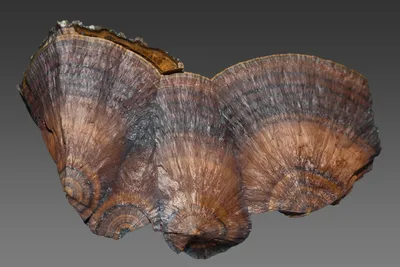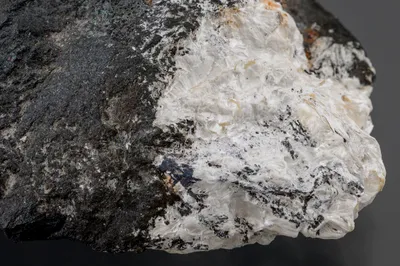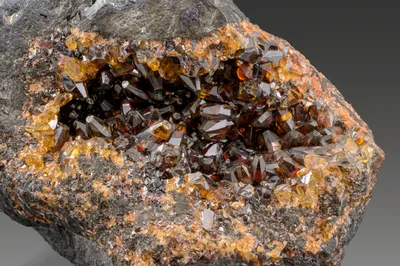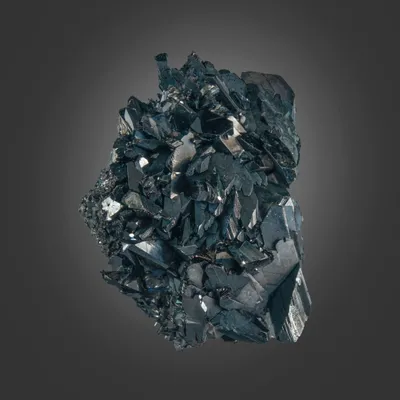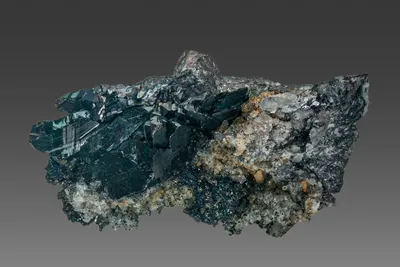
Image Credit: Malcolm Southwood
Mineral Species
Schneiderhöhnite
Type Locality
Yes
Composition
Fe2+Fe3+3As3+5O13
Crystal System
Triclinic
Status at Tsumeb
Confirmed (type locality)
Abundance
Very rare
Distribution
Second and third oxidation zones
Paragenesis
Supergene
Entry Number
Species; TSNB309
Type Mineralogy
The type specimen of schneiderhöhnite was found in 1972 "… when opening an insignificant cavity" in chalcocite / tennantite ore at West 120 a few metres below 29 Level in the second oxidation zone (Ottemann et al. 1974). An unidentified mineral from the cavity was found to be a new zinc arsenite, IMA 1973.046, and named for Hans Schneiderhöhn (1887-1962), a professor of mineralogy at the University of Freiburg in Germany, and a pioneer of mineralogical and geological research at Tsumeb (Ottemann et al. 1974). The crystal structure was reviewed by Hawthorne (1985). Type material is conserved at the Royal Ontario Museum, Toronto (catalogue number M33238).
General Notes
The cavity that yielded the type specimen for schneiderhöhnite was located in dolomite-chert breccia, close to a contact with the feldspathic sandstone. Secondary chalcocite fills cavities and cracks in the breccia and the crystals of schneiderhöhnite (to 7 mm) occurred on the chalcocite, accompanied by subordinate crystals of zincian stottite (to 5 mm). Ore microscopy showed that the sulphide component of the matrix also contained traces of pyrite, tennantite and galena. The schneiderhöhnite crystals were described as deep brown, semi-opaque, with a metallic to adamantine lustre (Ottemann et al. 1974).
Pinch and Wilson (1977) noted that schneiderhöhnite "Occurs in small crystal aggregates associated with stottite, molybdenite and secondary chalcocite. The color is dark brown to black, the luster is admantine and the size ranges up to 15 mm. It has three cleavages, one perfect, and many ‘crystals’ are actually only cleavages." Regarding the association with molybdenite, they described a single known specimen with a 3 cm crystal of hexagonal, pyramidal molybdenite associated with stottite and schneiderhöhnite.
Cesbron et al. (1977) described leiteite from Tsumeb and included a note on a specimen in the Natural History Museum, London, (catalogue number BM.1976,235), on which both leiteite and schneiderhöhnite are associated. They also observed that reinerite, like schneiderhöhnite, was discovered a few metres below 29 Level and that stottite was associated with the original discovery of schneiderhöhnite. They proposed that all of these minerals are part of the same paragenesis. In this context it is notable that leiteite, reinerite and schneiderhöhnite are all arsenites in which the occurrence of arsenic in its As (III) oxidation state indicates formation under conditions of reduced oxidation potential.
Keller (1977a) placed schneiderhöhnite in one of his "rare parageneses", R/3, as follows:
R/3: quartz >> chalcocite >> schneiderhöhnite >> stottite
Keller (1984) extended this paragenesis to include brunogeierite, claudetite, leiteite, ludlockite, scorodite and stottite.
Keller and Innes (1986) reported "… numerous finds with leiteite, ludlockite, schneiderhöhnite and schaurteite from W96 on 30 Level and from W20 to W40 on 32 Level".
Lombaard et al. (1986) listed schneiderhöhnite as a "very rare" mineral.
Gebhard and Schlüter (1995) reported schneiderhöhnite from 46 Level in the third oxidation zone in a paragenesis with leiteite, ludlockite, koritnigite, and köttigite. Their description of ludlockite as "… yellow to ochre-coloured felted aggregates" suggests that at least some of this material may have been karibibite (which had not been recognised at Tsumeb at that time).
Gebhard (1999) reported that the largest crystal of schneiderhöhnite is a flat, tabular crystal measuring 30 mm across.
An extraordinary example of schneiderhöhnite is in the collection of the Canadian Museum of Natural History (catalogue number CMNMC 56739). It was formerly in the Pinch Collection and is illustrated by Bainbridge (2020; page 67). The display face of a 4 cm specimen is completely covered by free-standing, loosely intergrown, terminated crystals of lustrous schneiderhöhnite. Two similar specimens, also from the Pinch Collection, are now in the collections at Harvard University (MGMH 2020.7.0693 and 2020.7.0694). These two specimens were recovered by TCL mineralogist John Innes from 32 Level, West 40, in July 1983.
Associated Minerals
arseniosiderite; arsenohopeite; brunogeierite; chalcocite; claudetite (?); ferrilotharmeyerite; goethite; hematite; karibibite; koritnigite; köttigite; krieselite; leiteite; ludlockite; molybdenite; ojuelaite; schaurteite; scorodite; siderite; smithsonite; stottite; tennantite-(Zn)


